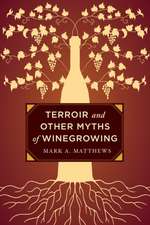Inedible Meat by-Products: Advances in Meat Research, cartea 8
Autor A. M. Pearson, T. R. Dutsonen Limba Engleză Paperback – aug 2012
Preț: 395.25 lei
Nou
Puncte Express: 593
Preț estimativ în valută:
75.64€ • 78.52$ • 63.07£
75.64€ • 78.52$ • 63.07£
Carte tipărită la comandă
Livrare economică 24 martie-07 aprilie
Preluare comenzi: 021 569.72.76
Specificații
ISBN-13: 9789401179355
ISBN-10: 9401179352
Pagini: 440
Ilustrații: XX, 416 p. 20 illus.
Dimensiuni: 152 x 229 x 23 mm
Greutate: 0.59 kg
Ediția:Softcover reprint of the original 1st ed. 1992
Editura: SPRINGER NETHERLANDS
Colecția Springer
Seria Advances in Meat Research
Locul publicării:Dordrecht, Netherlands
ISBN-10: 9401179352
Pagini: 440
Ilustrații: XX, 416 p. 20 illus.
Dimensiuni: 152 x 229 x 23 mm
Greutate: 0.59 kg
Ediția:Softcover reprint of the original 1st ed. 1992
Editura: SPRINGER NETHERLANDS
Colecția Springer
Seria Advances in Meat Research
Locul publicării:Dordrecht, Netherlands
Public țintă
ResearchCuprins
1. An Overview of Inedible Meat, Poultry and Fishery By-Products.- I. Introduction.- II. Raw Materials.- III. Classification and Utilization.- IV. Processing.- V. Volumes and Economic Impact.- VI. Import and Export Markets.- VII. Changing Nature of Markets.- VIII. New Opportunities.- IX. Conclusions.- X. References.- 2. Handling, Grading, and Curing of Hides and Skins.- I. Introduction.- II. The Animal Hide or Skin.- III. Curing/Preservation of Raw Hides and Skins.- IV. Marketing of Hides and Skins.- V. Export of Hides and Skins.- VI. Future of Hide and Skin Preservation and Marketing.- VII. Summary.- VIII. References.- 3. The Tanning Process and the Production of Finished Leather Goods.- I. Raw Material Types and Sources.- II. Temporary Preservation of Raw Material.- III. Leather Manufacturing Technology.- IV. Leather Goods Production.- V. Industry Trends.- VI. Summary.- VII. References.- 4. Wool and Hair.- I. Introduction.- II. Production Alternatives—Costs and Benefits.- III. Wool.- IV. Hair.- V. Summary.- VI. References.- 5. Blood Meal, Meat and Bone Meal and Tallow.- I. Introduction.- II. Blood Meal.- III. Meat and Bone Scraps, Tallows and Meat and Bone Meals.- IV. Grades of Tallows and Greases.- V. Meat and Bone Meals.- VI. Uses of Tallows and Meat Meals.- VII. Summary.- VIII. References.- 6. Inedible Fats and Greases.- I. Introduction.- II. Processing.- III. Classification and Quality Assessment of Rendered Animal Fats.- IV. Production and Usage of Inedible Tallow and Greases.- V. Fat Digestion by Ruminant and Nonruminant Animals.- VI. Nutritional Characteristics of Rendered Fats.- VII. Uses and Selection of Fats for Livestock Diets.- VIII. Production of Fatty acids and Lubricants from Inedible Fats and Greases.- IX. Summary.- X. References.- 7. Soap andDetergents.- I. Early History of Soap Making.- II. Chemistry of Soapmaking.- III. Raw Materials Used in Soap Manufacture.- IV. Physical and Chemical Properties of Soap.- V. How Soap Works.- VI. Influence of Raw Materials on Physical and Chemical Properties of Soap.- VII. Soap-Making Processes.- VIII. Detergents.- IX. Summary.- X. References.- 8. Feathers, Feather Meal and Other Poultry By-Products.- I. Introduction.- II. Feathers.- III. Feather Meal.- IV. Hackle Feathers for Fly Tying.- V. Blood Meal (BM).- VI. Inedible Poultry By-Product Meal (PBPM).- VII. Poultry Hatchery By-Product.- VIII. Other Poultry Wastes—Hatchery Wastes, Dead Birds, Wastage from Egg-Breaking Plants and Slaughter-House Wastes.- IX. Summary.- X. References.- 9. Fish Processing By-Products and their Recalamation.- I. Introduction.- II. Fish Meal and Its Production.- III. Other Fishery By-Products—Production and Uses.- IV. Other Uses of Fish Processing Waste.- V. Future Considerations.- VI. References.- 10. Inedible Gelatin and Glue.- I. Introduction.- II. Gelatin Quality Grades.- III. Collagen Raw Materials.- IV. Gelatin and Glue-Making Processes.- V. Physical and Chemical Testing and Standards.- VI. Properties of Gelatin Solutions, Gels and Solids.- VII. Photographic Uses of Gelatin.- VIII. Summary.- IX. References.- 11. Methods of Disposal of Paunch Contents with Emphasis on Composting.- I. Introduction.- II. Characteristics of Paunch Manure.- III. Methods of Disposal.- IV. Composting Methodology.- V. Summary.- VI. References.- 12. Pharmaceutical and Biological Products.- I. Introduction.- II. Animal Products as Nutritional Supplements.- III. Animal Products Used as Pharmaceuticals.- IV. Summary.- V. References.- 13. Inedible Meat, Poultry and Fish By-Products in Pet Foods.- I. Importanceof Inedible Meat By-Products in Pet Foods.- II. Sources of By-Products for Pet Foods.- III. Use of By-Products in Pet Foods.- IV. Competition and Allocation of By-Products Between Pet Foods and Other Uses.- V. Special Processing for Pet Foods.- VI. Types of Pet Food and Uses of By-Products.- VII. New Problems-Bovine Spongiform Encephalopathy (BSE).- VIII. Summary.- IX. References.- 14. Leathers Used in Sporting Goods.- I. Introduction.- II. Guidelines for Selection of Rawstock.- III. Tanning Sporting Goods Leathers.- IV. Summary.- V. References.- 15. Land Application of Paunch Manure and Blood.- I. Introduction.- II. Production and Characteristics of Manure, Blood and Paunch Manure.- III. Land Application.- IV. Soil Properties, Transportation and Application of Packinghouse Waste.- V. Example Problem for Land Application of Animal Processing Waste.- VI. Summary.- VII. References.- 16. Reduction of Pollution and Reclamation of Packinghouse Waste Products.- I. Introduction.- II. The Recycling Concept.- III. Water.- IV. Air Pollution.- V. Collection and Disposal of Solid Waste.- VI. External Noise Abatement.- VII. Summary.- VIII. References.


























